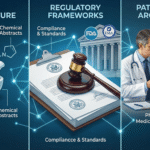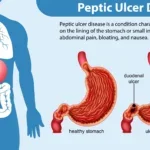1 · Overview
Atropine, hyoscyamine and scopolamine are tropane alkaloids concentrated in plants of the Solanaceae family—most notably Atropa belladonna (deadly nightshade) and Datura stramonium (jimson-weed). These compounds act as potent competitive antagonists at muscarinic acetylcholine receptors, producing the classic “anticholinergic toxidrome.” Untreated, severe poisoning may culminate in seizures, hyperthermia, rhabdomyolysis, dysrhythmia or respiratory failure [1] [2].
2 · Causes & Modes of Exposure
- Accidental ingestion of attractive belladonna berries by children or misidentified wild greens mixed with edible plants [1] [6].
- Recreational consumption of Datura seeds, teas or smoked leaves for their hallucinogenic effect; alkaloid content is unpredictable and easily leads to overdose [1].
- Medication error—excess parenteral or ophthalmic atropine during medical treatment, especially in paediatrics or anaesthesia [1].
- Unregulated herbal products containing belladonna alkaloids in mislabeled doses [1].
3 · Pathophysiology
Tropane alkaloids freely cross the blood-brain barrier and reversibly block M1-3 receptors in peripheral organs and the CNS. The loss of parasympathetic tone yields:
- Peripheral effects: anhidrosis → hyperthermia; tachycardia; mydriasis; urinary retention; ileus.
- Central effects: agitation, vivid visual hallucinations, disorientation, delirium and, with high doses, seizures or coma [1] [3].
4 · Clinical Features – “Anticholinergic Toxidrome”
| Mnemonic | Manifestations |
|---|---|
| Hot as a hare | Hyperthermia (↓ sweating) |
| Blind as a bat | Mydriasis, blurred vision, photophobia |
| Dry as a bone | Dry mouth, dry skin, absent bowel sounds |
| Red as a beet | Cutaneous flushing |
| Mad as a hatter | Agitated delirium, hallucinations, picking behaviour |
Additional findings: sinus tachycardia, hypertension (or later hypotension), ataxia, urinary retention, decreased lacrimation and cough reflex, possible ventricular dysrhythmias in severe cases [1] [5].
5 · Differential Diagnosis
- Sympathomimetic toxidrome (cocaine, amphetamines) – sweaty patient vs. dry skin.
- Serotonin syndrome – clonus > anticholinergic “dryness”.
- Neuroleptic malignant syndrome – drug history, rigidity.
- Delirium from infection, stroke or metabolic derangement.
6 · Diagnostic Approach
- Bedside evaluation: history of plant or drug exposure, characteristic vitals, pupillary exam and skin moisture [1] [6].
- Laboratory: electrolytes, creatine kinase (hyperthermia), creatinine; ECG for QRS/QT prolongation.
- Toxicology screens rarely detect tropanes rapidly; diagnosis remains clinical [1].
7 · Management & Treatment
7.1 Initial Stabilisation
- Airway / Breathing / Circulation (ABC) – intubate if airway reflexes fail or agitation compromises oxygenation.
- Cardiac monitoring for dysrhythmias; treat wide-complex tachycardia with sodium bicarbonate.
- Active cooling (evaporative, ice packs) if temperature > 38.5 °C.
7.2 Gastrointestinal Decontamination
Activated charcoal 1 g/kg orally/NG if presentation < 1 h post-ingestion and airway protected [6] [8]. Gastric lavage is seldom required.
7.3 Antidotal Therapy – Physostigmine
- Central acting reversible acetylcholinesterase inhibitor; counteracts both peripheral and CNS blockade.
- Adult dose: 1–2 mg IV slow push (0.5 mg/min); paediatric: 0.02 mg/kg (max 0.5 mg) – may repeat every 10–15 min if symptoms recur [5] [6].
- Contra-indications: suspected tricyclic antidepressant overdose (risk of asystole), AV block, severe asthma.
7.4 Symptomatic & Supportive Measures
- Benzodiazepines (diazepam or lorazepam) for agitation or seizures.
- IV fluids for rhabdomyolysis risk, Foley catheter for urinary retention.
- Anti-pyretics ineffective because fever is anticholinergic in origin—focus on external cooling.
- Consider lipid emulsion therapy if refractory cardiovascular collapse (rare case reports).
8 · Prognosis
With prompt recognition and physostigmine therapy, most patients recover within 24–48 h without sequelae. Delay or misdiagnosis may allow complications—heat stroke, aspiration pneumonia, ventricular tachycardia or multi-organ failure—to elevate morbidity and mortality, particularly in children and the elderly [[6]].
9 · Prevention & Public Health Notes
- Educate foragers and gardeners to identify Solanaceae plants accurately.
- Secure ophthalmic or parenteral atropine to prevent accidental paediatric access.
- Regulate over-the-counter herbal products containing belladonna alkaloids.
- School programmes warning adolescents about the dangers of so-called “natural” hallucinogens.
10 · Key Take-Home Points
- Atropine, hyoscyamine and scopolamine produce a distinct dry, flushed, delirious toxidrome.
- Diagnosis is clinical; sweat absence plus mydriasis and tachycardia are red flags.
- Physostigmine is the antidote of choice when serious CNS or cardiac manifestations emerge.
- Timely supportive care—airway control, cooling, benzodiazepines—prevents fatal complications.
- Accidental ingestion, especially in children, underscores the need for community education on toxic plants.
📚 AI Pharma Quiz Generator
🎉 Quiz Results
Medical Disclaimer
The medical information on this post is for general educational purposes only and is provided by Pharmacology Mentor. While we strive to keep content current and accurate, Pharmacology Mentor makes no representations or warranties, express or implied, regarding the completeness, accuracy, reliability, suitability, or availability of the post, the website, or any information, products, services, or related graphics for any purpose. This content is not a substitute for professional medical advice, diagnosis, or treatment; always seek the advice of your physician or other qualified health provider with any questions you may have regarding a medical condition and never disregard or delay seeking professional advice because of something you have read here. Reliance on any information provided is solely at your own risk.









